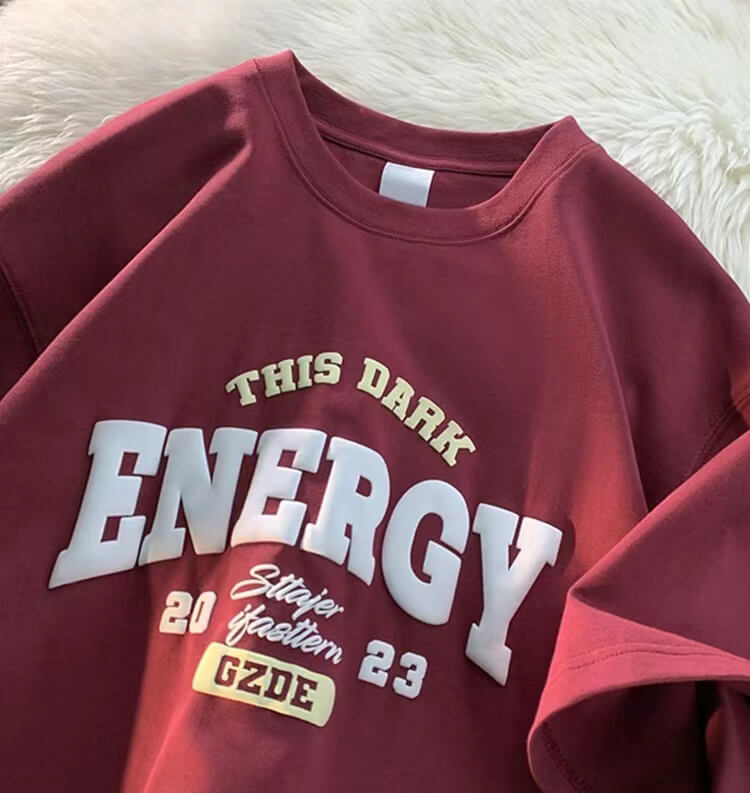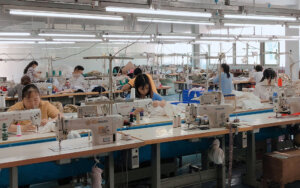As a professional clothing manufacturer, I’ve seen various printing techniques come and go, but puff printing stands out for its unique texture and durability. Understanding its history, techniques, applications, and benefits can help you appreciate why puff printing is a favored method in the industry. Whether you’re a designer, fashion enthusiast, or someone new to garment printing, this guide will provide you with all the essential information you need to know about puff printing.
Puff printing is a screen printing method that uses specialty ink mixed with a heat-activated foaming agent. When the printed garment passes through the dryer, the ink expands and creates a raised, textured effect.
Next I’ll share with you more about puff printing based on my experience.
The History of Puff Printing
Puff printing, also known as 3D printing or foam printing, has its roots in the 1980s when screen printers began experimenting with different techniques to add texture and dimension to their designs.
Originally used for novelty items, puff printing quickly gained traction in the fashion industry due to its unique aesthetic appeal.
Over the years, advancements in printing technology and materials have refined the process and it is now more popular in streetwear.
How to Puff Printing
Puff printing involves a standard screen printing process with an added twist. Here’s a step-by-step guide:
1.Design Preparation: The desired design is created and transferred onto a screen.
2.Mixing the Ink: Specialty puff ink is prepared by mixing regular screen printing ink with a heat-activated foaming agent.
3.Printing: The ink is applied to the fabric using the screen, just like in traditional screen printing.
4.Heating: The printed garment is passed through a dryer where the heat activates the foaming agent, causing the ink to expand and create a raised effect.
5.Curing: The garment is then cured to ensure the print adheres properly and maintains its raised texture.
Applications of Puff Printing
Puff printing is versatile and can be used on various fabrics and products. Common applications include:
T-Shirts: Puff prints add a unique texture to graphic tees, making designs stand out.

Hoodies and Sweatshirts: The raised prints enhance casual wear, adding a tactile element.

Accessories: Items like hats, bags, and even shoes can feature puff prints for added style.

Advantage and Disadvantage of Puff Printing
Considering both the pros and cons helps you make informed choices about whether puff printing is the right method for your specific needs. It ensures that you are prepared to maximize the benefits while effectively managing any potential drawbacks, leading to better overall outcomes for your projects and products.
Pros
Puff printing offers several advantages, making it a popular choice for custom apparel:
- Durability: The raised texture contributes to the longevity of the design, even after multiple washes.
- Visual Appeal: The 3D effect adds depth and interest to designs, making them more visually appealing.
- Versatility: Puff printing works well on various fabrics and can be used for different types of garments and accessories.
Cons
- Cost: Puff printing is generally more expensive than regular screen printing due to the additional materials and specialized techniques required.
- Complexity: The process is more complex, necessitating precise control over temperature and ink consistency. This complexity can lead to longer production times and higher chances of errors.
- Limited Detail: Puff printing may not be suitable for designs with fine details or intricate patterns, as the puff effect can obscure small details.
Is Puff Printing Expensive?
Puff printing often costs more than regular printing, especially for small custom orders.
This is because puff ink requires an extra ingredient—the foaming agent—and the expertise to manipulate the ink correctly.
However, the added cost is justified by the unique texture and durability of the prints.
Does Puff Print Come Off?
While puff prints are durable, they can be damaged by hot water or aggressive washing.
To maintain the integrity of the print, it’s essential to wash garments with puff prints in cold water and avoid high heat when drying.
Puff Printing vs. Screen Printing

Puff printing is a variation of traditional screen printing, with the key difference being the addition of a foaming agent to the ink. This agent causes the ink to expand and create a raised texture when heated. Traditional screen printing results in flat designs, while puff printing adds a unique 3D effect.
| Aspect | Puff Printing | Screen Printing |
|---|---|---|
| Definition | Uses specialty ink mixed with a heat-activated foaming agent to create a raised, textured effect. | Applies ink directly onto the fabric to create flat designs. |
| Texture | Creates a 3D, raised texture. | Results in flat, smooth designs. |
| Process | Requires an additional foaming agent mixed with the ink and a heat activation step. | Involves applying ink through a mesh screen onto the fabric. |
| Cost | Typically more expensive due to the extra materials and steps involved. | Generally less expensive for standard designs. |
| Durability | Highly durable if properly cared for; maintains vibrant appearance after multiple washes. | Durable, but may not have the same longevity as puff prints. |
Puff Printing on Fabric
puff screen printing is suitable for a wide range of fabrics, but works best on materials that can withstand high temperatures because it reacts the special additives in the printing ink to create a swelling effect.
Fabrics best suited for Puff printing:
Cotton: This is the most popular choice for puff printing because it withstands the heat necessary to raise the ink and also holds the puff design well over time.
Cotton Blends: Blends of cotton with synthetic fibers like polyester can also be good candidates, as they combine durability with the ability to handle heat.
Polyester: While pure polyester can be used, it requires careful handling to prevent scorching under high heat. It’s advisable to use a lower temperature puff additive for polyester fabrics.
Canvas: This heavier material is great for puff printing, particularly for items like tote bags or heavy-duty apparel.
Fabrics not suited for puff printing
Nylon: Due to its low melting point, nylon can easily get damaged by the high temperatures required to activate puff ink.
Acrylic: Similar to nylon, acrylic fabrics are also prone to melting and distorting under high heat, making them unsuitable for puff printing.
Rayon: Although rayon can withstand some heat, it is generally sensitive and may shrink or warp when subjected to the temperatures needed for puff printing.
Silk: This delicate fabric is highly sensitive to heat and prone to damage, making puff printing a risky choice.
When choosing a fabric for puff printing, it’s essential to consider how the fabric reacts to heat and how much detail the design requires. Stretchy or very thin fabrics may not be ideal as they can distort the design due to their elasticity or inability to handle the high temperatures needed to activate the puff ink effectively.
Summary
Puff printing offers a unique and durable way to enhance garment designs. With proper care, these prints can last and maintain their vibrant appearance, making them a valuable addition to any wardrobe.





